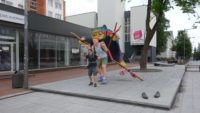 Mer had a museum day planned for today, and one of the slightly odd aspects of the museums we saw today was their lack of concern for keeping the years in strict order.
Mer had a museum day planned for today, and one of the slightly odd aspects of the museums we saw today was their lack of concern for keeping the years in strict order.
The final museum we saw today was the Frenkelis Villa Museum. Chaimas Frenkelis was a Jewish leather worker who came to Šiauliai because Šiauliai had excellent railroad connections. He started a little leather-working business, and ended up with a huge factory that had some people calling Šiauliai the “leather capital of the world.” Frenkelis came here in the late 1800s, and eventually had a mansion built next to his factory.
I know next to nothing about leather, but Frenkelis came up with ways to make it soft, and with high quality. His product took off, and he became very wealthy (this was in the early 1900s, before the Soviets came in the 1940s). He seemed to be a decent man, supporting Jewish culture and city establishments, helping his workers, and more. He was awarded a medal from the government of Lithuania for his social involvement.
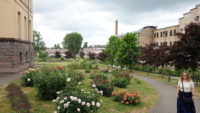 Then World War I came. I had not known that Lithuania was on the German/Russian front lines, but it was. The Russians were forced back, and Germany took Šiauliai for a couple of years. In their doing so, sixty percent of the buildings in the city were destroyed, and I think the population dropped by three quarters. Frenkelis fled with his family to Russia before the Germans got here. The family came back after the war, but Frenkelis died soon after. His son rebuilt the factory, but it never reached the pre-war production it had enjoyed.
Then World War I came. I had not known that Lithuania was on the German/Russian front lines, but it was. The Russians were forced back, and Germany took Šiauliai for a couple of years. In their doing so, sixty percent of the buildings in the city were destroyed, and I think the population dropped by three quarters. Frenkelis fled with his family to Russia before the Germans got here. The family came back after the war, but Frenkelis died soon after. His son rebuilt the factory, but it never reached the pre-war production it had enjoyed.
My villa history gets a little muddy in and around World War 2. As far as I can tell, the Germans used the house as a headquarters, and then later the Soviets turned it into a hospital for fifty years. When it was finally turned back over to Lithuania in the early nineties, it was in rough shape. The house was restored, and I’m glad it was.
The house is now home to a history of industry in the area, but we could only look at pictures since we can’t read Lithuanian. The second floor held art in most of the rooms, except for the dining room, which was set up for a formal dinner. That was all fine, but the gem of the tour was the house. Look up and look down in great houses. The floors were all wooden and were lovely, but the ceilings were gems. The house was built in an art-deco style, and I’m a big fan. Every room had a different ceiling, and many were deco in style. Some were simple, and some were more complex, but they were all compelling. I want to deco my ceilings now.
Our tour took about an hour, and we closed the place out. We were still able to enjoy the pretty rose gardens of the home – it is open until 10:00 to the public as a park. There were all kinds of roses, which were in bloom, and a cool four-headed fountain, all with the house as a backdrop. Mer and I sat on a bench next to the fountain and relaxed.
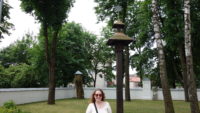 After church, Mer took us back toward our hotel. We were looking for a specific address, but it seems Šiauliai has a novel way of numbering addresses. Even numbers are on one side, and odd numbers are on the other. Fine. But the evens and the odds don’t have anything to do with each other. House number 42 is across the street from house 23. It can make finding a building difficult. We were looking for number 47, and when we got to 45, the next building changed because it was on a crossroad. Okay. But then the next number was also out of order, because that address was still attached to the first building, even if that was around the corner. We finally found 47, but it was harder than it could have been.
After church, Mer took us back toward our hotel. We were looking for a specific address, but it seems Šiauliai has a novel way of numbering addresses. Even numbers are on one side, and odd numbers are on the other. Fine. But the evens and the odds don’t have anything to do with each other. House number 42 is across the street from house 23. It can make finding a building difficult. We were looking for number 47, and when we got to 45, the next building changed because it was on a crossroad. Okay. But then the next number was also out of order, because that address was still attached to the first building, even if that was around the corner. We finally found 47, but it was harder than it could have been.
Mer had brought us to the Šiauliai History Museum. That was fun, as it has been hard for us to keep track of the complicated twists of Lithuanian history, and especially that of the last 250 years. The museum is a decent size, with three levels of exhibits. We started in the basement, which covered pre-history to about 1300. There was one exhibit safety sensor in the whole museum, over a simulated grave with some early bones and artifacts. I set it off by pointing at something for Mer. Serves me right.
The second floor made a jump to about 1700. I think. The second floor played loose with this whole chronology thing. One placard would talk about 1800, and the next would be about 1750. The exhibit picked up in the early 1800s, but still had a mysterious order to events. As far as I can tell, and this isn’t authoritative, Šiauliai history went something like this: the Duke of the Grand Duchy of Lithuania set up Šiauliai as some sort of economic zone, and rented it to rich people. They had the job of keeping the economy going, but making sure it stayed under some level, or the city would become a “free city.” At some point, a duke bought the whole place and kept it for himself, and it eventually became a free city. One duke was forward-thinking and did a lot of good for his farmers by hosting agricultural exhibitions and modernizing equipment. On the bigger stage, it sounded as if Poland-Lithuania got broken up by Russia in the 1800s, who in turn got booted by Lithuania after WW I. Then I think Poland came back in until 1941, when the Germans rolled in. They lost the war, and the Soviets took over for fifty years until 1991. Simple.
The third floor of the museum was my favorite. I had notice over the last few days that there are carved wooden sculptures everywhere in Lithuania – many are religious in nature, but Šiauliai has many quirky ones in the park next to our hotel. The third floor of the museum was almost all carvings, from religious statues to coat racks to bobbins for wool to masks for holidays. Standing before an entire wall of carved wooden crucifixes is impressive. They also had one case of highly decorated eggs that were so detailed as to take them well past the realm of folk art. It was a fun place to explore.
We left the hotel after breakfast and walked toward the main square. As we got to the cathedral, Mer steered us into the church. She declared that people go to church on Sundays. Even people who don’t speak the language. So, our second Mass in a Lithuanian cathedral. It was quite beautiful. The cathedral was surprisingly simple and harmonious inside. It was painted all white, and the windows were prismed clear glass instead of stained glass. Even the Stations of the Cross were made of white plaster or wood or such.
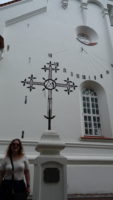 And then the music got off to a great start. The opening song was sung by a small men’s choir accompanied by an acoustic guitar. I had never heard a guitar in a cathedral service before, and it worked really well for the tune they were singing. The men singers kept singing throughout parts of the service, but the organ played the rest of the time until the last song, which was guitar and voices again. In that acoustic space, it was special.
And then the music got off to a great start. The opening song was sung by a small men’s choir accompanied by an acoustic guitar. I had never heard a guitar in a cathedral service before, and it worked really well for the tune they were singing. The men singers kept singing throughout parts of the service, but the organ played the rest of the time until the last song, which was guitar and voices again. In that acoustic space, it was special.
I also liked that the bishop proceeded down the aisle, making eye contact with people and blessing them with the sign of the cross. When he saw two children, he stopped even though the rest of the processional in front kept going. He laid his hands on the children’s heads and smiled. It was touching.
The rest of the service was interesting to see what we could recognize, which wasn’t much, but wasn’t nothing either. In all, it was a good way to start the day. We left the cathedral and circled around it, looking at the many wooden sculptures that were on the grounds, as well as a large sundial next to a pretty metal cross.
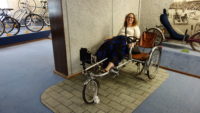 After the history museum, we headed back down to the pedestrian street and took it to almost the other end, where Mer continued her museum day with the Bicycle Museum. This museum had three floors, although really only the top two had bikes on display. We thought we would see the evolution of the bike over time, but that again shows my narrow-minded approach to time. There were military bicycles from the 1940s next to a tandem bicycle from the 1980s. We discovered that Šiauliai has had a well-respected bike factory since the 1950s or so, and that explains why the museum is here. They had the one millionth and five millionth bikes produced on display.
After the history museum, we headed back down to the pedestrian street and took it to almost the other end, where Mer continued her museum day with the Bicycle Museum. This museum had three floors, although really only the top two had bikes on display. We thought we would see the evolution of the bike over time, but that again shows my narrow-minded approach to time. There were military bicycles from the 1940s next to a tandem bicycle from the 1980s. We discovered that Šiauliai has had a well-respected bike factory since the 1950s or so, and that explains why the museum is here. They had the one millionth and five millionth bikes produced on display.
It surprised me how many bikes were just one-speed bikes you associate with French women pedaling though the countryside with a front basket of wine and a baguette. Probably seventy-five percent were of that variety. They did have two weird semi-unicycles from the 1980s – they were like unicycles with training wheels – they had one big wheel with pedals attached, but had two very tiny (think roller skates) wheels attached out in front to lean into. I’m not sure what market they were trying to hit, but one was from the United States and one from Germany, so someone thought there was a market.
From the pictures of athletes on the wall, it looks as if Lithuania has a successful women’s bicycle program – most of the pictures were women. There was also a story of a seventy-three-year-old Lithuanian man who organized a trans-USSR ride. Sadly, he died in an accident along the way, but the ride did finish. Another Lithuanian man, a forty-seven-year-old physicist, organized a “ride around the world” trip of five continents, starting in Seattle and finishing in Hiroshima. He wanted to promote peace and sustainability, and over six hundred people took part in the ride at some point (four people total finished the fifteen-thousand-mile ride).
We had surprisingly great weather today for a day forecast to be raining much of the day. It never rained at all. After supper, we were walking back to the hotel, a bit disappointed that we had missed getting dessert from a bakery by just a minute or so (they had just closed), when we heard classical music from the park next to the hotel. We walked over to investigate. Just as we got to the outdoor amphitheater, the music stopped, and people started spilling out onto the walkways. We were disappointed, but siren-like, the music had led us on to an ice cream stand that was open. We had dessert in a lovely park.
So, all in all, a very good day. No rain and still dessert and we learned a bunch about the local area. Here’s hoping tomorrow lines up at least as well.
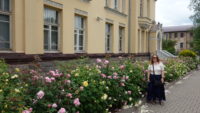 When the alarm went off this morning, we could hear hard rain against the skylight of our room. That was a bit discouraging, but we got ready and went downstairs to have an excellent breakfast. It was funny – the American guys who work for the defense contractor were down there, so there were five Americans and two Italians in the breakfast room. It sounded as if we were at Bob Evans. Anyway, by the time we were done, the rain had stopped, so we were off on another day of touring adventure (with Meredith in charge).
When the alarm went off this morning, we could hear hard rain against the skylight of our room. That was a bit discouraging, but we got ready and went downstairs to have an excellent breakfast. It was funny – the American guys who work for the defense contractor were down there, so there were five Americans and two Italians in the breakfast room. It sounded as if we were at Bob Evans. Anyway, by the time we were done, the rain had stopped, so we were off on another day of touring adventure (with Meredith in charge).